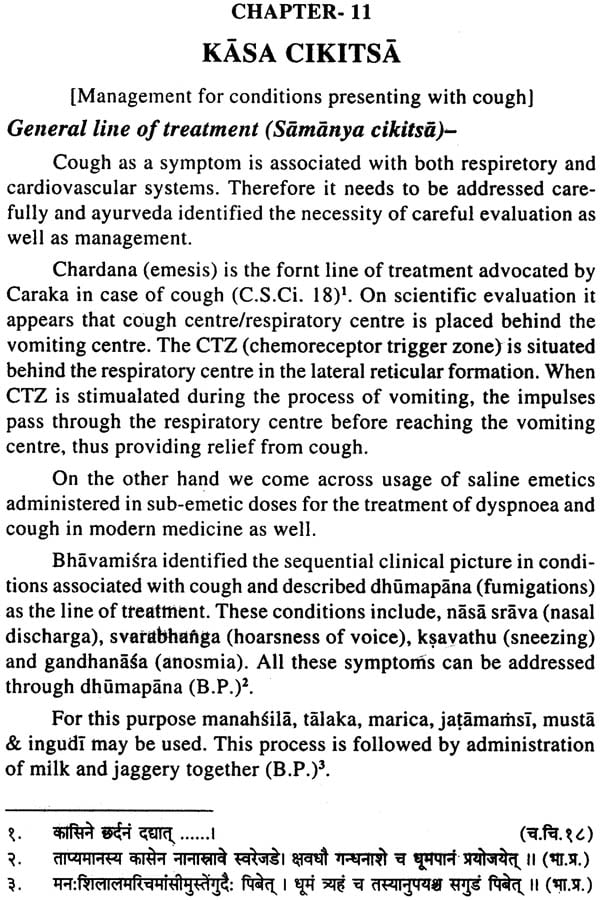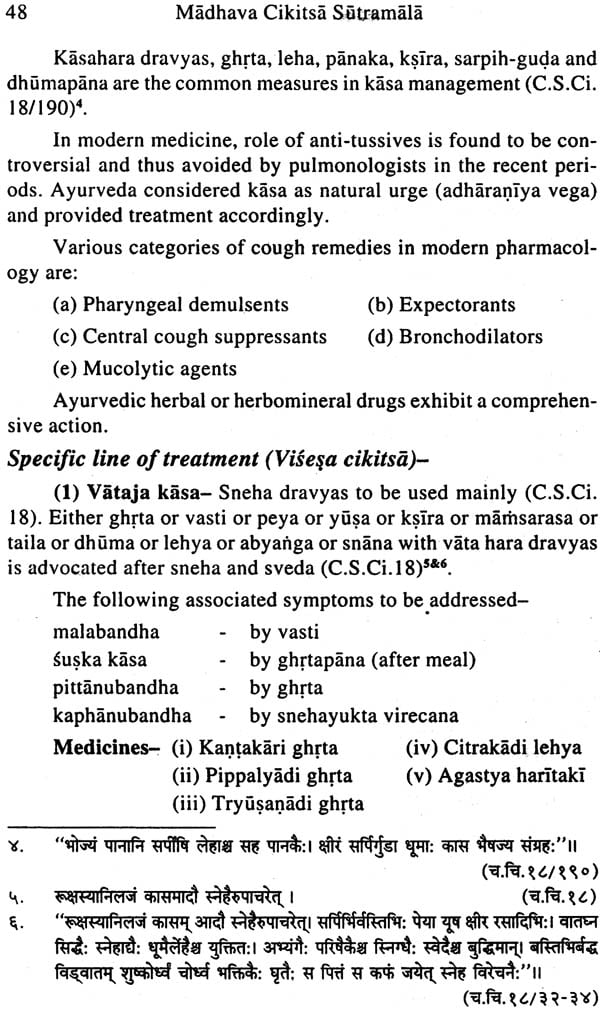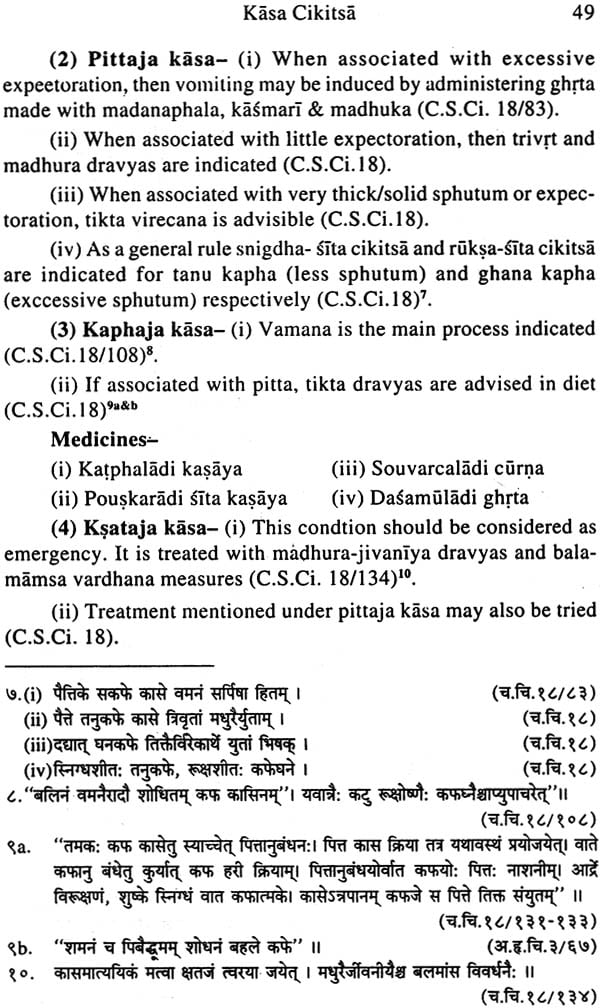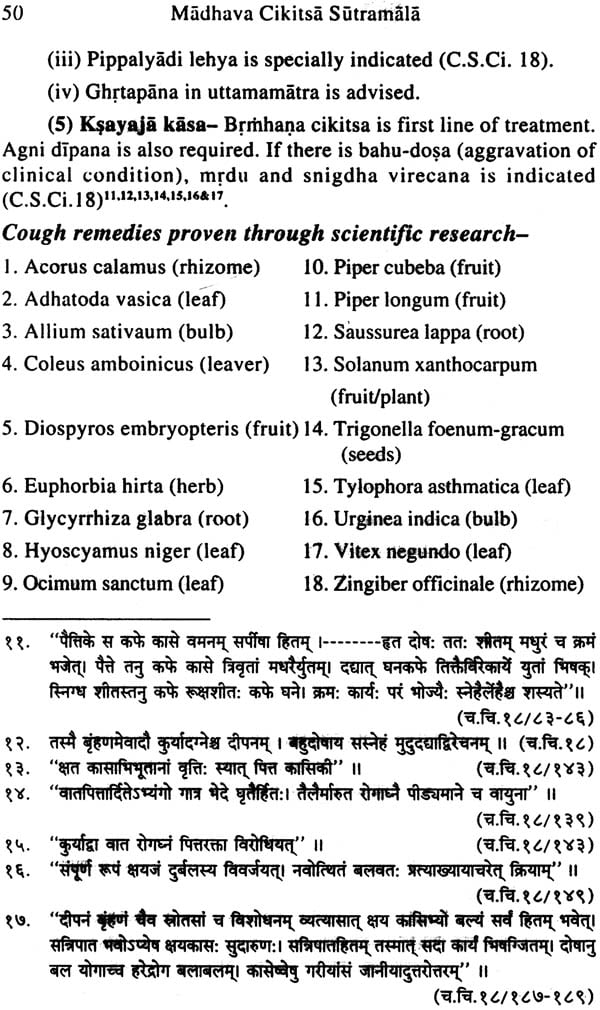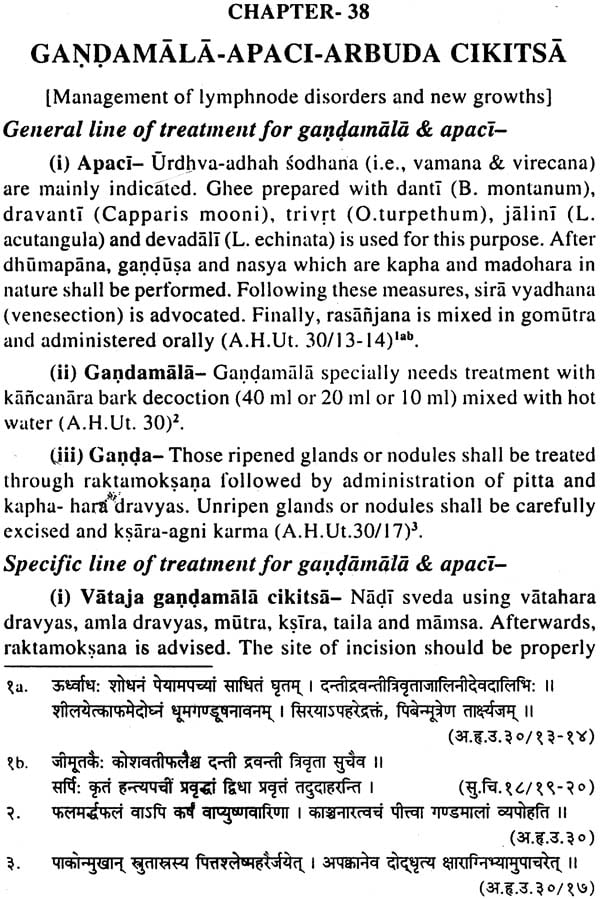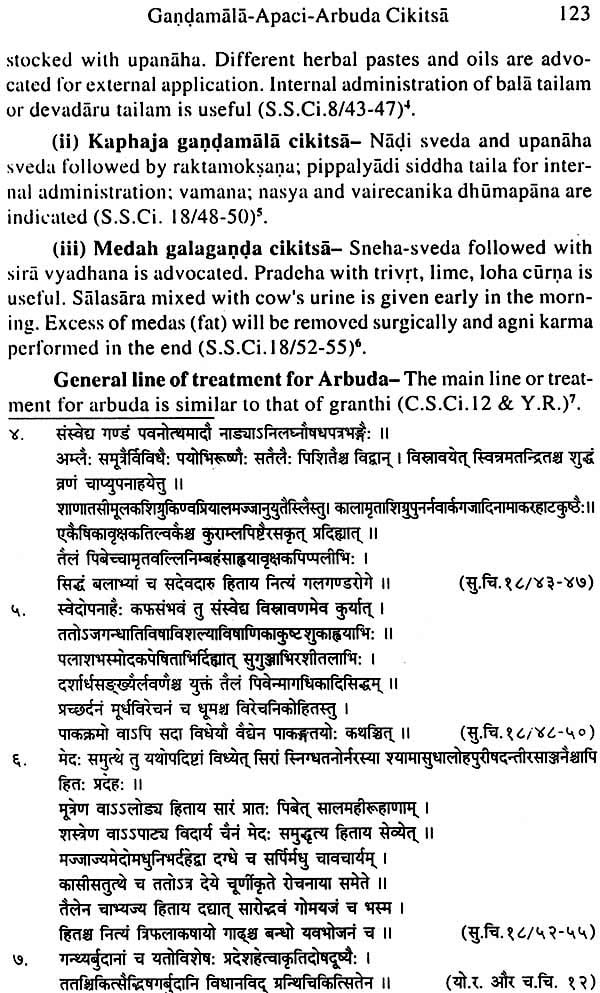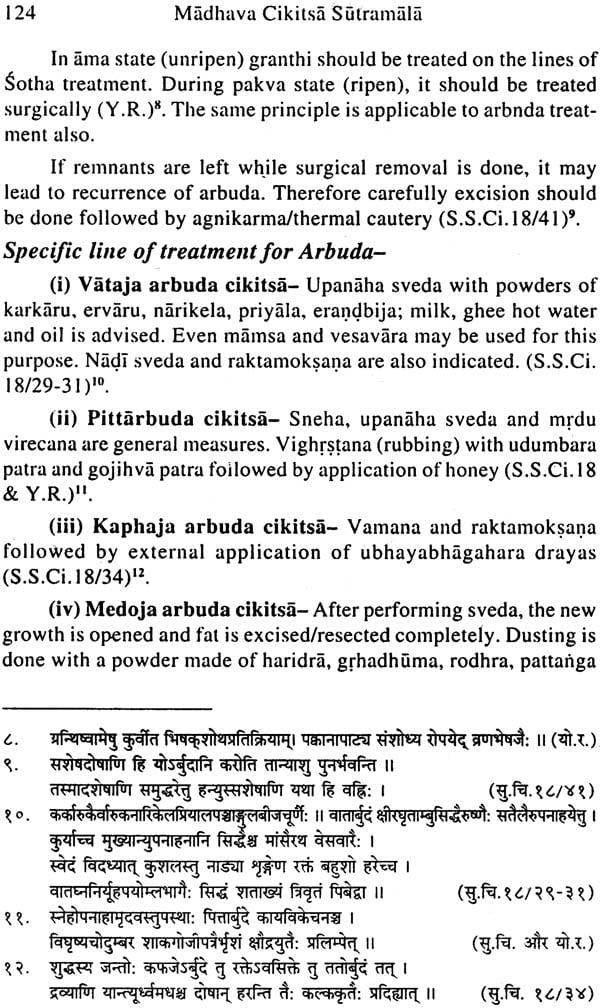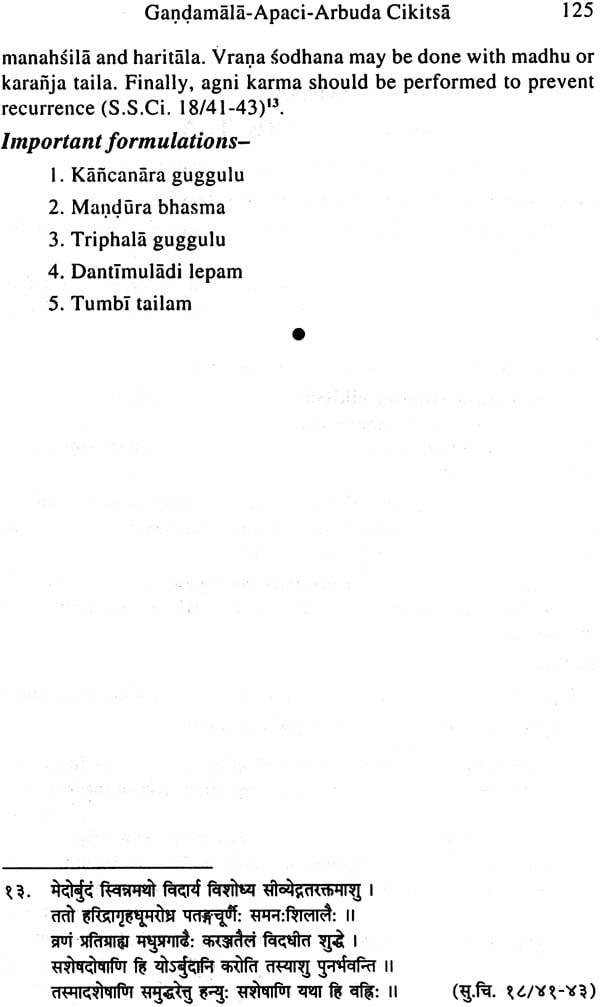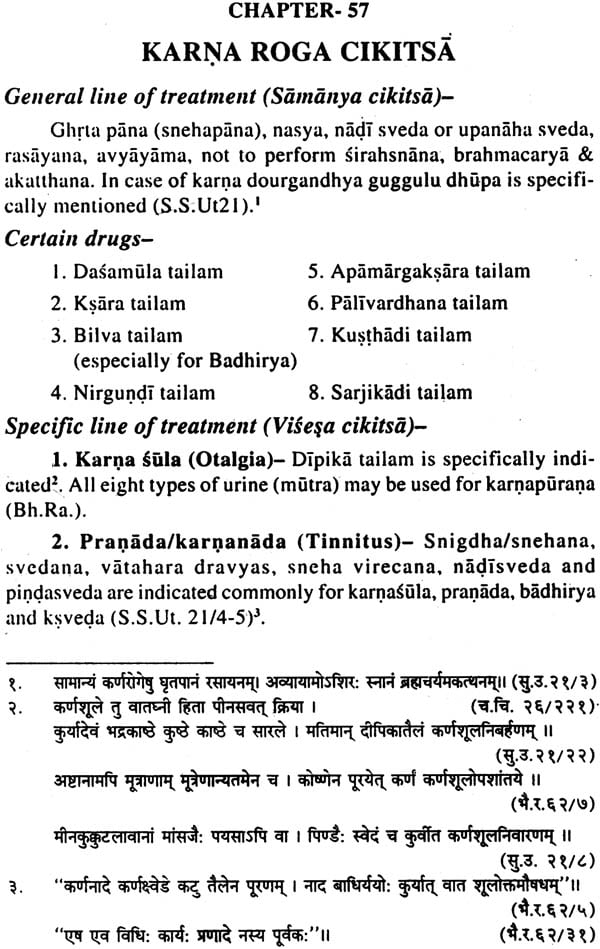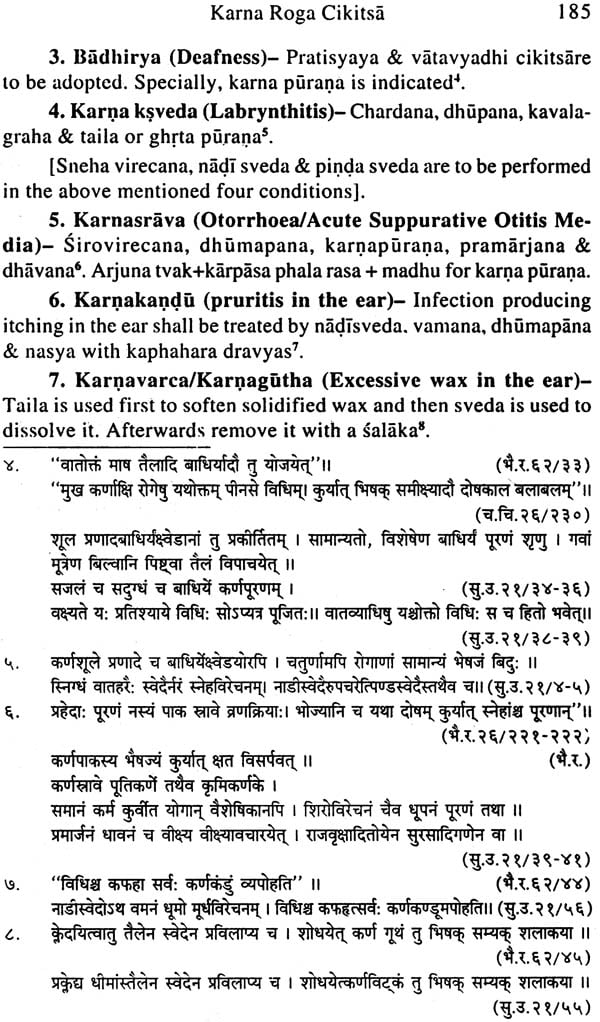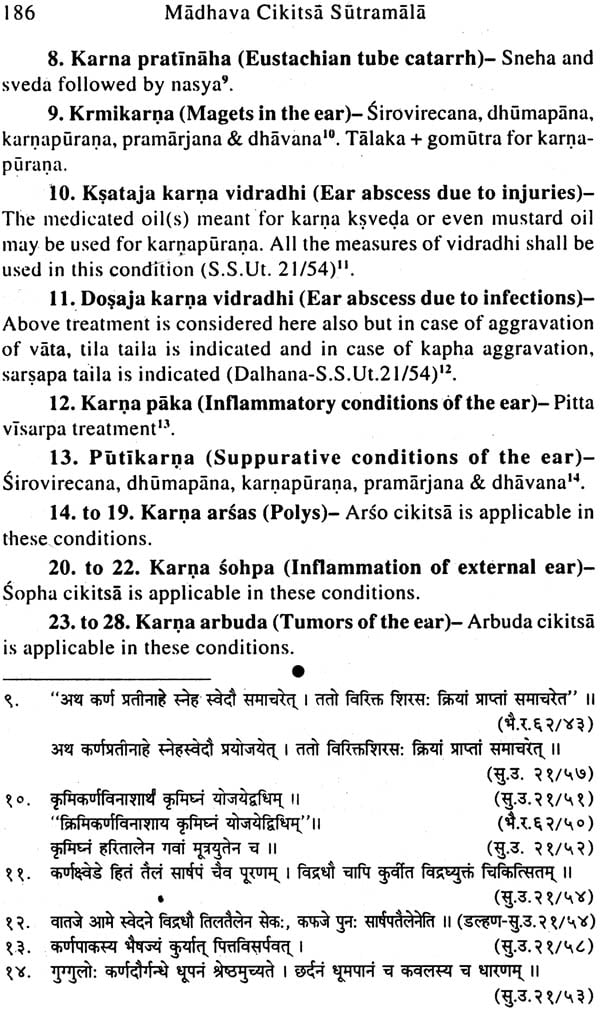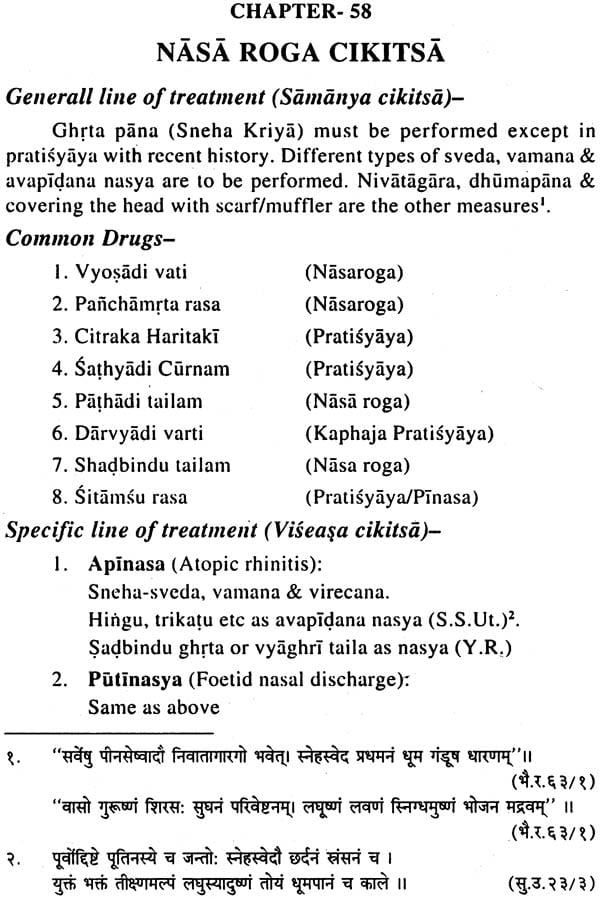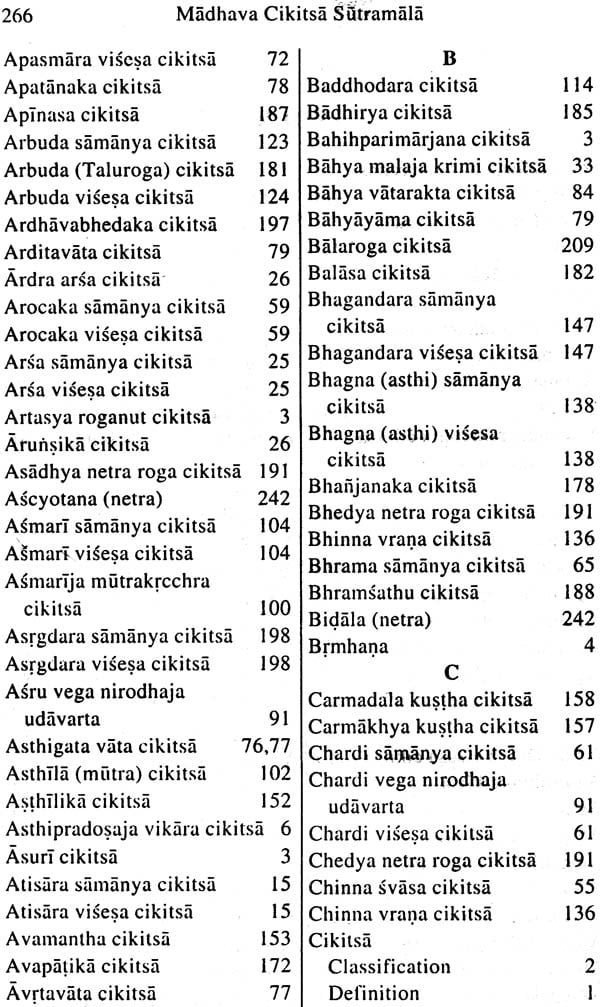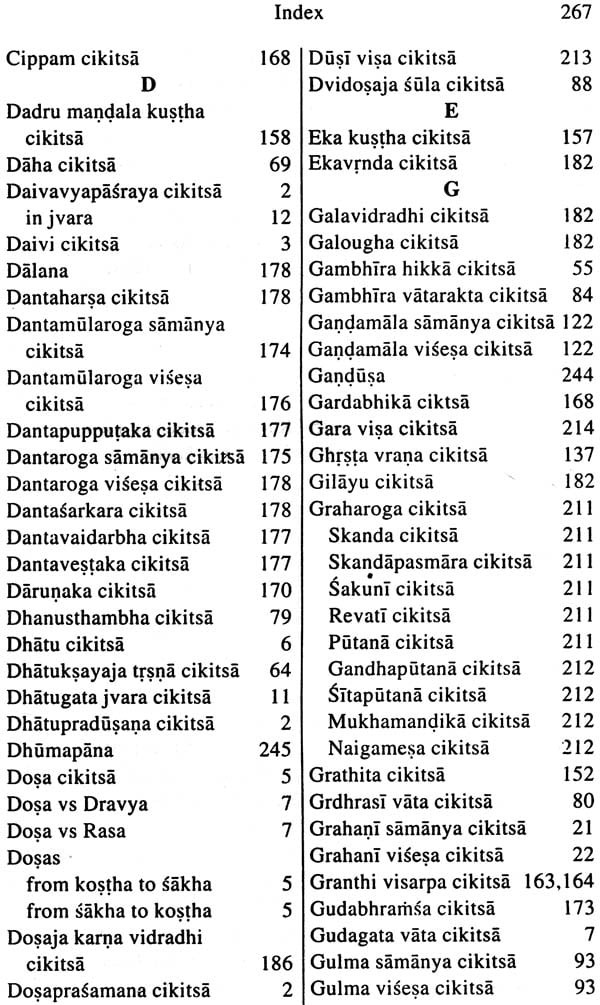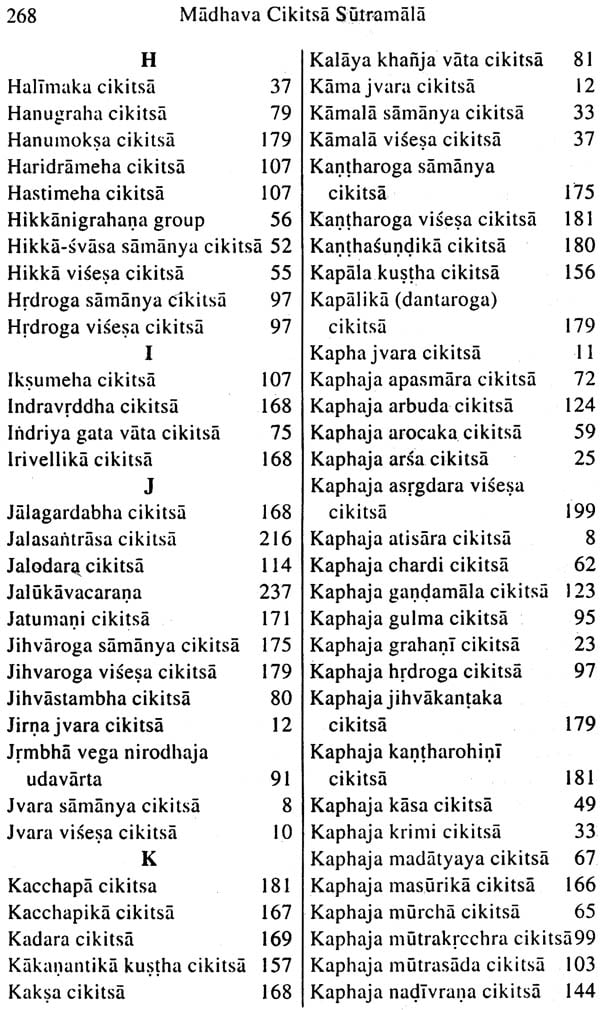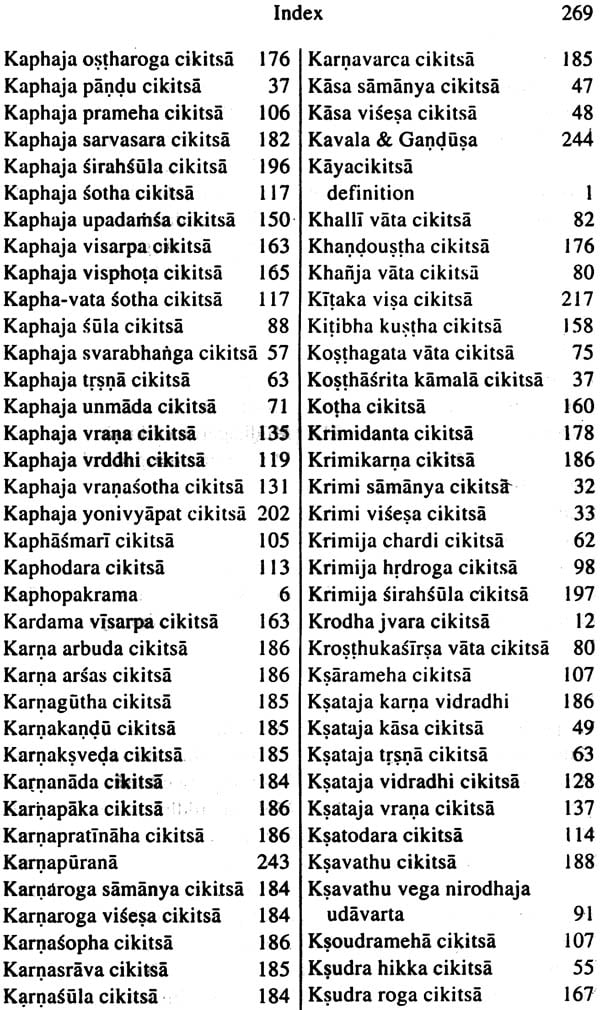
Madhava Cikitsa Sutramala (Treatment for Diseases Mentioned in Madhava Nidana)
Book Specification
| Item Code: | NAI250 |
| Author: | Dr. J.L.N. Sastry & Dr. V. Lakshmana Prasad |
| Publisher: | CHAUKHAMBHA ORIENTALIA, Varanasi |
| Language: | Sanskrit Text with English Translation |
| Edition: | 2007 |
| ISBN: | 9788176370363 |
| Pages: | 288 |
| Cover: | Hardcover |
| Other Details | 8.5 inch x 5.5 inch |
| Weight | 430 gm |
Book Description
This text is first of its kind as it covered the treatment as per the chronology of diseases described in Madhava Nidama. This text precisely covers the treatment part on the basis of Cikitsa Sutras (line of treatment) given in different texts. Lucid compilation is made covering the Samanya Cikitsa (general line of treatment ) & Visesa Cikitsa (specific line of treatment ) of all the 69 chapters of Madhava Nidana.
This text will enable an amateur Ayurvedic student to utilize classical Ayurvedic principles in clinical practice. There is no need to search different texts to find Cikitsa Sutras. All are made available at one place. Therefore, it will be a referral text for the teachers as well as for the practitioners.
Author’s clinical experiences are real value addition to this work. These aspects have been incorporated where ever felt necessary. Looking at the contents of the work, the title Madhava Sutramala is testified.
Dr. Sastry is born in 1965 at a place called Narasapuram, Wets Godavari Dist. Of A.P. He belongs to an illustrious family of Ayurvedic physicians. His grandfather Ayurveda Visarada Late Jatavallabhula Lakshminarayana Sastry (1904-76) was a famous Nadi Vaid while father Dr. J. Krishnamurty who is a graduate in modern medicine is continuing yomen services to human kind through practice of Ayurveda. The tradition of Ayurveda is descend from famous Vaids, Marla brothers (Vd. Marla Narasimha Sastry & Vd. Marla Narayana Sastry ) of Kakinada. This family traditionally prepare and dispend the Ayurvedic medicines to the patients without any commercial element.
Dr. Sastry graduated in first division from Dr. N.R.S. Govt. Ayu. College, Vijaywada in 1989. He received two gold medals from Nagarjuna University in for aggregate and total number of marks in BAMS. He completed post-graduation from Dr. B.R.K.R. Govt. Ayu. College, Hyderabad in 1998 with Dravyaguna speciality. His dissertation received one gold medal (from Ayurveda Sastrajana Parishad, Vijayawada) and one silver medal (Academy of Ayurveda, Vijayawada).
He was a topper in BAMS, M.D. (Ayu.), APPSC, UPSC. He also posses two certificates in Sanskrit from Dakshina Baharata Sanskrita Prachara Sabha, Chittore, A.P. He worked as medical officer (Ayu.) under govt. of Andhra Pradesh for 7 years (1992-2004); as medical advisor Ayurveda, Dabur India Ltd. And head clinical research, Dabur Research Foundation for 3 ½ years (2004-2007).
He had an extensive list of publication viz., about 10 texts & reference books; about 50 articles & scientific papers in journals and about 20 different articles & columns in news papers. He has also given several TV and Radio interviews covering various topics.
He is currently acting as the Chief Consulting Physician, Ayushman Ayurvedic Center, Kakinada, Andhra Pradesh and Managing Director, Jata’s Ayurvedic Health Care Systems. He is also acting as advisor for International Educational Faculty for Clinical Research (IFCR), Cochin and for Venkataramana Ayurvedic College, Chennai.
First of all, I wish to congratulate the authors for their novelistic and original approach in bringing out Madhava Cikitsa Sutramala. Often a teacher trains his/her student’s claiming-Nidane Madhavah Sresthah. This statement creates enthusiasm in the students mind and due to its concised compilation provides comfort the students is looking for. However, actual problem begins when the same student wants to covert his knowledge into practice. Mainly, he/she cannot get the line of treatment from one single book in the same chronology. This work identified the need gaps of students and practitioners of Ayurveda and presented Cikitsa Sutras in the chronology of Madhava Nidana.
Though some scholars claim that Madhava Dravyaguna and Vrnda Madhava are the other works of author of Madhava Nidana, the practical utility of the concept is neither seen in academic institutes nor in Ayurvedic clinics. Sri N.N. Dasgupta observed that Srikanthadatta quoted a work by name “Madhava Cikitsa” written by Vrnda. Even Niscalakara mentioned a work entitled “Madhaava Sangraha” in his commentary on Cakrapani’s Cikitsasara Sangraha. According to Dr. Srikanthamurthy there are many manuscripts of “Madhava Cikitsa” available in India and abroad in the oriental libraries. But none of these manuscripts are published. I wish the authors will make efforts in the direction of publication of these works too.
I know Dr. Sastry’s innovative thinking as a student as well as a colleague. In this work Dr. J.L.N. Sastry & Dr. V. Lakshmana Prasad have aptly complied Cikitsa sutras for various disease conditions mentioned in Madhava Nidana. At the same time, the authors have lucidly followed the original concepts of Madhavakara i.e. Nati Sankshepa Vistarah
All the disease were arranged in the chronological order in this work but the first chapter raise the eye-brows of many for the way it is dealt. Author did try to share his experience at several places. The contribution will be more meaningful if a Pathyapathya Table is provided at the end of the work.
This work is a real salute/dedication to Mdahavakara. I wish that the author should bring out many more works for the benefit of students, teachers & practitioners of Ayurveda.
I specially appreciate M/s Chaukhambha Orientalia, Varanasi for publishing such important works.
Ayurveda regained popularity owing to its holistic approach towards health/disease management and Ayurveda is that the former is ‘disease contious’ while the later is aimed at eliminating the root cause of the disease than elimination of the symptoms of disease. However, the recent trends in Ayurvedic practice indicate symptomatic treatment approach.
The authors have noticed several non-classical approaches in the treatment like: kamala being treated with bhumyamalaki; madhumeha being treated with ajesrngika etc. When we carefully review the literature, classical Ayurvedic texts did nit indicates bhumyamalaki for jaundice. Similarly, gudmar was not added to any formulation in the classical Ayurvedic texts for the management of madhumeha. This herb was quoted by Bhavamishra and it should be used individually for the management of diabetes but not in combination.
The main cause for concern is, lack of knowledge on ‘Cikitsa sutras’ mentioned in the classical texts. Students often feel that it is difficult to refer various texts to compile and study the Cikitsa sutras. Therefore, there is a need to present these Cikitsa sutras in a lucid form the utility of students as well as practitioners.
Earlier, Vrndamadhava made an attempt in his work provide Cikitsa on the basis of Madhava nidana. The authors have made similar effort to compile the Cikitsa sutras as per the disease order of madhavanidana. Hence, the text is entitled as “Madhava Cikitsa Sutramala”. While arranging the subject matter in order, several practical points and personal experiences have been incorporated in this work .
This work will definitely help the practitioners of Ayurveda to adopt the Cikitsa sutras in a simplified form in day to day practice. This text will also help in resurgence of classical treatment approach in clinical practice. Necessity of wholesome approach in Ayurvedic practice is submitted in an authoritative manner. This work deserve the applauds of learned and learning scholars of Ayurveda.
The author conveys their gratitude to Dr. P.B.A. Venkatacharya, former Res. Officer, and Govt. Res. Dept. of Ayurveda, Hyderabad for writing the foreword for this work.
Authors sincerely thank the publishers for bringing out such an important book for the benefit of Ayurvedic community.
| Chapters | pages |
| 1. Cikitsa Siddhanta | 1 |
| 2. Jvara Cikitsa | 8 |
| 3. Atisara Cikitsa | 15 |
| 4. Grahani Cikitsa | 21 |
| 5. Arsas Cikitsa | 25 |
| 6. Agnimandya-ajirna Cikitsa | 29 |
| 7. Krimi Cikitsa | 32 |
| 8. Pandu-kamala Cikitsa | 36 |
| 9. Raktapitta Cikitsa | 39 |
| 10. Rajayaksma-ksataksina Cikitsa | 44 |
| 11. Kasa Cikitsa | 47 |
| 12. Hikka-svasa Cikitsa | 52 |
| 13. Svarabheda Cikitsa | 57 |
| 14. Arocaka Cikitsa | 59 |
| 15. Chardi Cikitsa | 61 |
| 16. Trsna Cikitsa | 63 |
| 17. Murcha bharma tandrasanyasa Cikitsa | 65 |
| 18. Madatyaya cikitsa | 67 |
| 19. Daha Cikitsa | 69 |
| 20. Unmada Cikitsa | 70 |
| 21. Apasmara Cikitsa | 72 |
| 22. Vatavyadhi Cikitsa | 73 |
| 23. Vatarakta Cikitsa | 83 |
| 24. Urustambha Cikitsa | 85 |
| 25. Amavata Cikitsa | 86 |
| 26. Sula Cikitsa | 87 |
| 27. Udavarta-anaha Cikitsa | 90 |
| 28. Gulma Cikitsa | 93 |
| 29. Hrdroga Cikitsa | 97 |
| 30. Mutrakrcchra Cikitsa | 99 |
| 31. Mutraghata Cikitsa | 102 |
| 32 .Asmari Cikitsa | 104 |
| 33. Premeha Cikitsa | 106 |
| 34. Medoroga Cikitsa | 110 |
| 35. Udara Cikitsa | 112 |
| 36. Sotha Cikitsa | 116 |
| 37. Vrddhi Cikitsa | 118 |
| 38. Galaganda-apaci-arbuda Cikitsa | 122 |
| 39. Slipada Cikitsa | 126 |
| 40. Vidradhi Cikitsa | 127 |
| 41. Vranasotha Cikitsa | 130 |
| 42. Sarita vrana Cikitsa | 132 |
| 43. Sadyovrana Cikitsa | 136 |
| 44. Bhagna Cikitsa | 138 |
| 45. Nadivrana Cikitsa | 144 |
| 46. Bhagandara Cikitsa | 146 |
| 47. Upadamsa Cikitsa | 149 |
| 48. Sukadosa Cikitsa | 151 |
| 49. Kustha Cikitsa | 154 |
| 50. Sitapitta-udarda Cikitsa | 160 |
| 51. Amlapitta Cikitsa | 161 |
| 52. Visarpa Cikitsa | 162 |
| 53. Visphota Cikitsa | 165 |
| 54. Masurika Cikitsa | 166 |
| 55. Ksudra roga Cikitsa | 167 |
| 56. Mukharoga Cikitsa | 174 |
| 57. Karnaroga Cikitsa | 184 |
| 58. Nasaroga Cikitsa | 187 |
| 59. Netroroga Cikitsa | 191 |
| 60. Siroroga Cikitsa | 196 |
| 61. Asrgdara Cikitsa | 198 |
| 62. Yoni vyapat Cikitsa | 200 |
| 63. Yoni kanda Cikitsa | 204 |
| 64. Mudhagarbha Cikitsa | 205 |
| 65. Sutika roga Cikitsa | 206 |
| 66. Stana roga Cikitsa | 207 |
| 67. Stanya dusti Cikitsa | 208 |
| 68. Bala roga Cikitsa | 209 |
| 69. Visa roga Cikitsa | 213 |
| Annex. I: Visayanukramanika | 219 |
| Annex. II: Pancakarma Procedures | 221 |
| Annex. III: Rasayana & vajikarana | 239 |
| Annex. IV: Kriya kalpas | 241 |
| Annex. V: Technical terms & meanings | 247 |
| Annex. VI: Plants mentioned in this book and their botanical names | 254 |
| Index | 265 |
